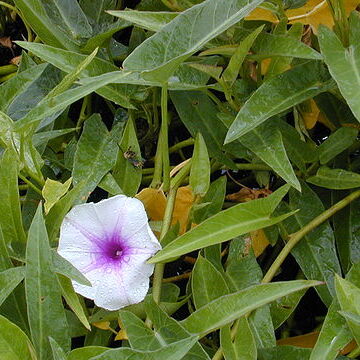Annual, biennial or perennial herbs or shrubs; stems woody or herbaceous, prostrate, twining or erect. Indumentum in the African species never stellate. Leaves exceedingly variable, entire or lobed, simple or rarely compound; pseudo-stipules sometimes present. Flowers axillary, solitary or in few-to many-flowered cymes, sometimes aggregated at the apices of shoots or enclosed in an involucre. Sepals very variable in size and shape, often unequal, foliaceous to coriaceous. Corolla regular, usually funnel-shaped, rarely trumpet-shaped, the limb sometimes salver-shaped, usually not conspicuously lobed, variously coloured. Pollen spinose or spinulose (Fig. 22/8, p. 131). Ovary 2-, 3-, 4-or rarely 5-locular, usually 4-ovuled, rarely 6–10–ovuled.; style filiform; stigma biglobular. Capsule ovoid or globose, 3–10–valved. Seeds usually 4 (rarely 3 or up to 10), glabrous, pubescent or clothed (sometimes only partly) with very long hairs.
Herbs or less commonly shrubs, usually with twining or trailing stems. Latex present, often white. Lvs simple, mostly petiolate; lamina very variable, from entire to lobed and finely dissected. Fls mostly in axillary cymes which are occasionally paniculate, sometimes solitary; bracts variously developed, not concealing calyx. Sepals 5, very variable, persistent and often enlarged at fruiting. Corolla small to large, 5-lobed, usually actinomorphic, occasionally slightly zygomorphic, contorted in bud, usually funnelform or campanulate, sometimes salverform or tubular, variously coloured; lobes usually very shallow; mid-petaline bands well-defined. Stamens 5, inserted near base of corolla tube, included or rarely exserted. Ovary 2-or 4-locular; each loculus usually with 4 ovules; style filiform; stigma capitate or with 1-3 globose lobes. Capsule usually 4-celled, rarely 6-celled, usually 4-seeded. Seeds glabrous or hairy.
Vines, shrubs or trees, usually twining, sometimes prostrate or floating. Leaves mostly petiolate, often variable in shape and size on the same plant, entire, lobed, divided, or rarely compound, the petiole occasionally with pseudostipules. Flowers mostly in axillary 1-to many-flowered dichasia, rarely paniculate; sepals herbaceous or subcoriaceous, variable in size and shape, glabrous or pubescent, often somewhat enlarged in fruit; corolla small to large, regular, or rarely slightly zygomorphic, mostly funnelform or campanulate, less often tubular or salverform, purple, red, pink, white, or yellow, the limb shallowly or rarely deeply lobed, the interplicae well defined by 2 distinct nerves; stamens included or rarely ex-serted, the filaments filiform, often triangular-dilated at the base, mostly un-equal in length; the pollen pantoporate, globose, spinulose; ovary usually 2-or
Herbs or shrubs, often twining, sometimes prostrate, erect, or floating. Leaves petiolate, entire, lobed, or divided. Inflorescences mostly axillary, cymose, 1-to many flowered, rarely paniculate; bracts various. Flowers small to large. Sepals persistent, equal to unequal, ± enlarged in fruit. Corolla variously colored, rarely yellow, funnelform, campanulate, or salverform; limb 5-lobed to entire, midpetaline bands well defined. Stamens included or exserted; filaments filiform, usually unequal, dilated and pubescent basally; anthers ovate or linear, longitudinally dehiscent, not twisted; pollen globular, pantoporate, finely spiny. Disc ringlike. Ovary 2-4-loculed, 4-or 6-ovuled. Style 1, filiform, included or exserted; stigma capitate, or 2-or 3-globulose. Capsule globose or ovoid, 4-or 6-valved. Seeds 4(-6) or fewer, glabrous or pubescent.
Fls 5-merous, large, ebracteate, axillary, solitary or in cymes. Outer calyx-lobes or sepals us. > inner, erect. Corolla us. broad-funnelform, limb sts angled or lobed. Staminal filaments filiform, sts dilated at base. Ovary us. 2-loculed, 4-ovuled. Style filiform, stigma capitate or with 2 globose lobes. Capsule us. subglobose, 4-valved. Seeds glab. or pubescent. Twining prostrate or scrambling herbs, often lianoid, with alt. variously cut lvs. A widespread, mostly maritime, genus of some 450 spp.
Sep 5, imbricate, often unequal; cor funnelform to campanulate or salverform, the margin entire, angled, or shallowly lobed; ovary 1–3-locular, with 2 ovules per locule, or sometimes 4-locellar by the development of partitions between the ovules; style 1, elongate; stigma entire or 2–3-lobed; capsule 2–4-valved; ours twining herbs with broad, cordate or lobed lvs and handsome fls produced singly or few together at the summit of axillary peduncles. 600+, cosmop. (Pharbitis, Quamoclit)
Flowers axillary, solitary or in few to many-flowered cymes, sometimes aggregated at the apices of shoots pseudo-capitate, or enclosed in an involucre or in cymes, rarely forming a terminal leafy panicle; peduncles short or long, rarely almost nil; pedicels usually distinct, rarely almost nil; bracts and bracteoles various, sometimes leafy, free or forming an involucre.
sometimes 4-locular, 4-ovulate, rarely 3-locular, 6-ovulate, glabrous or pubescent, the style simple, filiform, included or rarely exserted, the stigma capitate, entire or often 2(-3)-globose. Fruits globose or ovoid capsules, mostly 4(-6)-valved or rarely splitting irregularly; seeds 4, (6, or less), glabrous or pubescent.
A climber. The stem is woody near the base and is branched. The leaves are broadly oval. They can have 3 lobes. They are 5-17 cm long and 3.5-16 cm wide. The leaf stalk is 2-18 cm long. The fruit is a round capsule 1 cm across. There are 4 brown seeds inside.
Stamens 5, usually unequal, inserted near the base of the corolla tube, subincluded or sometimes exserted; filaments filiform or somewhat linear, often dilated and hairy or papillate at the base; anthers ovate to linear; pollen globose, spinose or spinulose.
Corolla usually regular, rarely faintly zygomorphic, usually funnel-shaped or the tube somewhat campanulate, sometimes hypocrateriform, usually not conspicuously lobed, variously coloured.
Leaves petioleate or rarely sessile exceedingly variable in shape and size, entire or lobed to deeply divided, simple or rarely compound; pseudo-stipules sometimes present.
Sepals 5, very variable in size and shape, often unequal, membranaceous to coriaceous, persistent, often more or less enlarged in fruit.
Ovary 2-3-4, or rarely 5-locular, usually 4-ovuled, rarely with 6–10 ovules; style filiform, included to exserted; stigma 2-globular.
Seeds usually 4 (rarely less by abortion or up to 10), glabrous, pubescent or clothed (sometimes only partly) with very long hairs.
Annuals, biennials or perennials, herbaceous, suffruticose or sometimes woody plants.
Stems woody or herbaceous, usually twining or prostrate, sometimes erect.
Capsule globose to avoid, 3–10-valved.
Disk annular.


